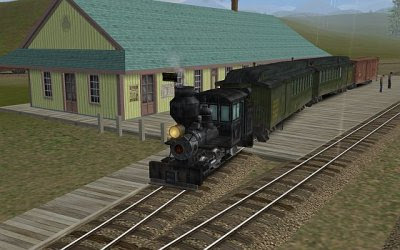
"Never waste a crisis." I didn't just make that up. I heard it on a cable news show recently. Its origins are probably ancient China. The obvious point is well known: a crisis brings change. It's often an opportunity, especially if we look for the opportunity with an open mind and act accordingly. Our global economic meltdown is one such crisis. I expect many things will change; most far more important than train simulation.
However, since this blog is about train simulation, the opportunity I'm speaking about is train simulation, especially for those who are not yet involved. If you need any economic reasons to look into train simulation as a "railroading fix," just have a look at the Walthers flyer that just arrived in my mailbox today. Walthers is the number one US supplier of everything model railroad and model railroad related. Their monthly flyer contains specially priced items for quick sale. Just quickly scanning the pages, I see in HO scale cabooses for $37.95 each, covered hopper cars for $21.98 each, and an EMD F3 diesel A-B set for $299.98. A 4-car set of NYCTA subway cars goes for $219.98. There's much less available in the smaller N scale where prices are somewhat lower. A standard 40 ft boxcar costs $15.98 and an RS-2 diesel switcher goes for $69.98. To be fair, you can find cheaper items as well as more expensive items at Walthers and in your local hobby shop. But generally speaking, you pay for what you get. So if you want quality appearance and performance, chances are the lowest priced items will not suffice (I DO have exceptions to this in my own collection, but not many).
If you want to build a model railroad, you will also need track, power control, buildings, scenery, vehicles and so on. (Did I mention space? Yes, there are clever things you can do in a shoebox.) Still, you could easily be in for $1000 before you had anything of consequence (unless you built a shoebox trolley layout, for example). By comparison, my year-old bottom of the line Dell laptop cost me under $500. On it I can run Microsoft Train Simulator ($7.50 at my VR Pro Shop), Trainz TRS2006 ($10 at my VR Pro Shop), and BVE versions 2 and 4 (both free). That's my total outlay. I have hundreds upon hundreds of add-on cars, locomotives layouts and so forth that I've downloaded for free. I've also contributed a lot of freeware myself, so it's not all take and no give.
Remember the 4-car subway set for just under $220? I have on Microsoft Train Simulator 3 great subway and elevated layouts - very nearly like the NYCTA prototypes, both in appearance and size - and a host of highly detailed and beautifully operating NYCTA/MTA rapid transit cars, including IND R10 in4 different paint schemes, IND R4 and R9 cars, IRT Gibbs cars, IRT Hedley cars, IRT Low-V cars, R15 cars in 2 paint schemes, R17 cars in 2 paint schemes, R22 cars, and R142A cars. Oh yes, I almost forgot the open end platform Third Avenue Elevated cars and the 19th century Manhattan Elevated tank locos. You couldn't physically build this much in layouts, let alone afford the rolling stock.
On Trainz I run Maine 2-footers and 30-inch gauge equipment. On BVE I run trains on routes from all around the world. My favorites are the London Underground routes and trains.
If you want to know more about train simulation, just visit my Virtual Railroader and V-Scaler websites. Both are loaded with articles covering all types of train/railroad sims. You will even find downloadable items and links to other sources of related interest.
If you have ever wondered about getting involved in train simulation, now is a great time. Don't let this economic crisis go to waste.
Cheers,
-- Al

